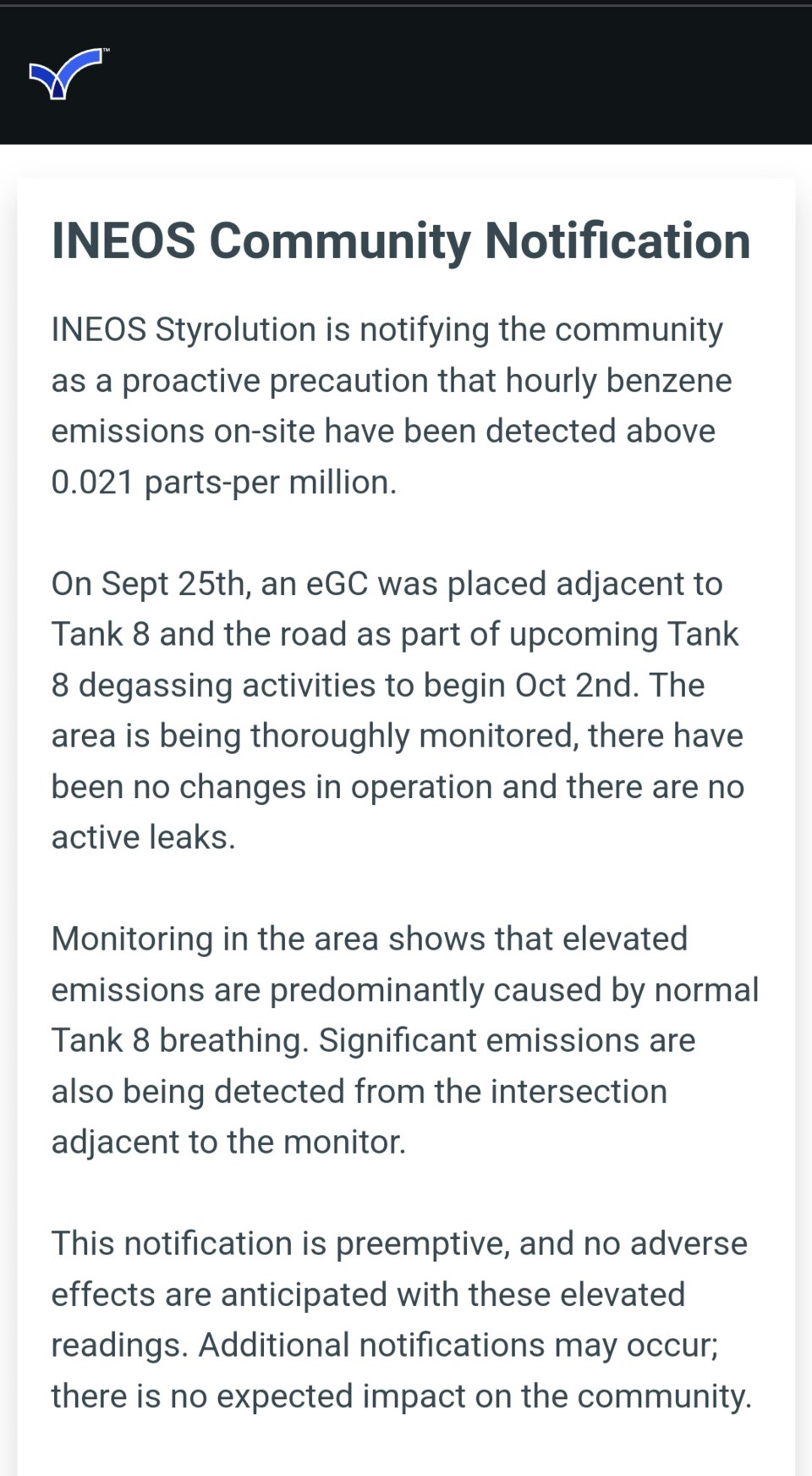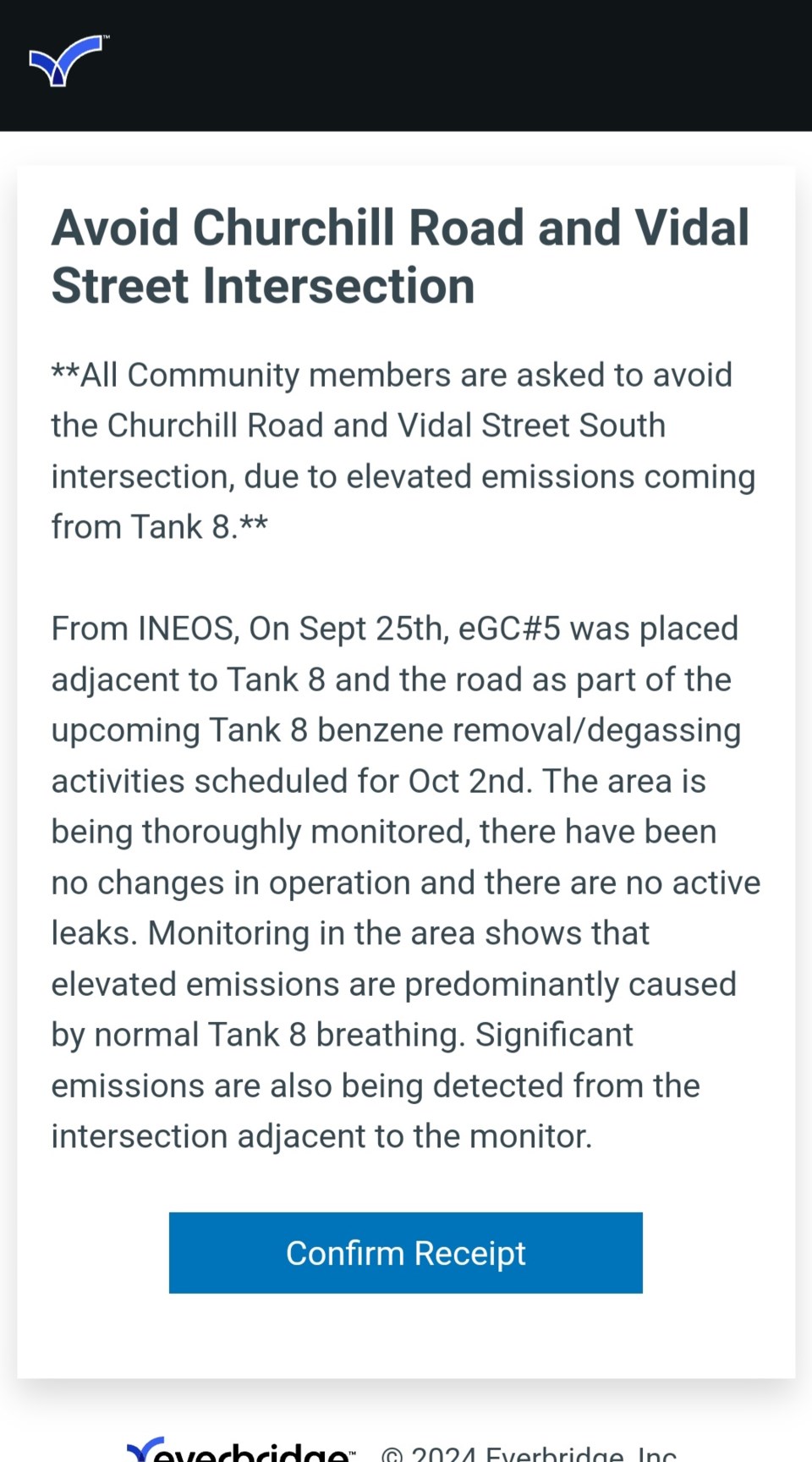The views expressed in this article are those of the author and do not reflect the position of The Sarnia Journal.
Aamjiwnaang First Nation has faced benzene exposure from INEOS Styrolution (INEOS) for years now, with concerns arising when the community installed their own air monitoring system in 2022 and received high readings of benzene. Since the Aamjiwnaang First Nation first put in air monitors, the benzene data has shown higher readings than the INEOS fence line monitors. Concerns in the community were first raised when the levels of this Group 1 carcinogen spiked in April of this year. Benzene levels in Aamjiwnaang exceed Ontario’s guidelines, which state that hourly average concentrations should not go beyond 90 µg/m3. However, Aamjiwnaang’s air monitoring system saw hourly benzene readings as high as 191.3 ug/m3 in April. Benzene is released through manufacturing of Styrofoam, plastics and rubbers. Inhaling benzene is linked to cancers, hormone disruption, reproductive and intergenerational effects, and breathing problems.
The evening of September 18th, Aamjiwnaang Chief and Council gathered community members of all ages in a meeting to inform them of the source of the benzene leak and the steps being taken by INEOS to remove the carcinogenic chemical from the 08 tank (located N/W of the Band Office on the corner of Vidal St. S, and Churchill Rd. (Hwy. 40)). The community event unveiled an INEOS Event Specific Evacuation Plan that was designed and developed by the Aamjiwnaang Emergency Control Group (AEGC) and provided the community with information on their Third Party Review of Sarnia Area Environment and Health Project. The AEGC was appointed by the Aamjiwnaang Chief and Council in May 2024. The community information meeting was held to inform community members about Chronic Benzene Exposure: What you need to know, which discussed the potential signs and symptoms of blood cancer. This is not the first time band operations have been disrupted by elevated benzene emissions from INEOS. For the past year, Aamjiwnaang has closed work buildings and parks multiple times when these incidents occur.
The community information meeting began with consultants of Aamjiwnaang, Scott and Cathy Grant, presenting that the benzene emissions INEOS is responsible for are “leaking” or being emitted by a failing floating roof within the tank. The company states “Logistical complexity of this non-routine activity should not be underestimated, Part A: De-inventory Bulk Volume above Internal Floating Roof Height. Part B: Benzene Removal below the Internal Floating Roof Height.” They stated that removal of the Benzene will take 3 days using both trucks and pipelines. Community members, including Ada Lockridge, brought up the concerns about the wind direction on the days of the removal of the benzene, as inhalation is a primary source of benzene exposure and its health impacts. The inadequate action by INEOS to prevent the leak from happening that has led to this removal process is very concerning as there are numerous other tanks owned by other companies, some of which are visibly rusty, that look just like INEOS’s leaking tank.
The INEOS Event Specific Evacuation Plan presented by Chief and Council and the AEGC states “Evacuation will occur if the reading reaches 27 ug/m3. As a precaution, the AEGC recommended that community members in predetermined zones should begin to be evacuated on October 1st. The evacuation order will end once the INEOS event is declared, and the benzene emissions are reading under 27 ug/m3 for a period of 24 hours”. This plan was initiated within the community by the Aamjiwnaang Emergency Control Group and not the parties responsible for the contamination or the Canadian government.
The evacuation of Aamjiwnaang residents on October 1st, follows the National Day For Truth and Reconciliation, reflecting the progress of the government’s reconciliation efforts with Indigenous peoples so far. This evacuation heads a trail of harmful chemical leaks which have gone on for over a century, most of which could have been prevented if adequate regulations and oversight were in place. Canada’s government is quick to talk and slow to act, which allows companies like INEOS to cut corners to save pennies while risking the lives of the surrounding community in the process. The regulations governing Sarnia’s petrochemical industry are unfortunately filled with loopholes and ambiguity that are contrary to protecting health. For example, although companies are required by federal law to report the amounts of pollutants they release annually to the National Pollutant Release Inventory (NPRI), there is no oversight to verify the values that are reported. In addition, cost-benefit analysis embedded in pollution regulation means that the economic costs to companies of reducing pollution is weighted as much or more than protecting health. Moreover, regulations give permission to undermine health-based air quality standards.
In 2005, Ontario introduced health-based air standards, after a health-based air standard was announced, INEOS and other chemical plants requested a sector-specific technical standard for benzene emissions (Petrochemical Industry Standard). That is, they requested for the health standard to not apply to them. These are just a few of the many regulatory failures that allow companies like INEOS to perpetually pollute Aamjiwnaang First Nation with little to no accountability. Until solutions to these glaring regulatory failures are created collaboratively with Aamjiwnaang leadership, reconciliation is just a word, and environmental racism remains the norm for the community of Aamjiwnaang.
Days before the benzene removal was to start at INEOS, community members began receiving several notifications reading “the proactive precaution that hourly benzene emissions on-site have been detected above 0.021 parts-per million.. No adverse effects are anticipated with these elevated readings. There is no expected impact on the community.. Note: INEOS Styrolution is not the only source of benzene in the area. Primary Contact Name: Shift Supervisor, Primary Contact Information: 226 784 3040.” The notifications persisted to alert Aamjiwnaang community members 5 days in a row, 3-5 times a day leading up to the scheduled removal of the benzene. During Aamjiwnaang’s National Day of Truth and Reconciliation Event at Maawn Doosh Gumig Pavillion and Memorial Monument on September 26th, community members received a notification from INEOS reading “**All Community members are asked to avoid the Churchill Road and Vidal Street South intersection, due to elevated emissions coming from Tank 8.**”


Lack of accountability, careless governments, and inadequate pollution regulations that fail to protect Aamjiwnaang make this one of the leading examples of environmental racism. 40% of Canada’s petro-chemical industries surround Aamjiwnaang First Nation with 60% of the highest-emitting within a 5km radius of the community. Despite Indigenous peoples making up only 5% of Canada’s population, over 16% of people who were internally displaced in Canada in 2023 were Indigenous people living on a reserve. This imbalance in displacement among Indigenous peoples in Canada will continue to be reinforced this week when INEOS Styrolution begins its plan to remove benzene from a high-emitting benzene tank.
Due to INEOS’ long history of chemical leaks into the community and lack of transparency, Aamjiwnaang’s Chief and Council have decided a precautionary evacuation is needed to ensure the health and safety of community members. Evacuations are to take place October 1st, and are expected to last several days. There is no safe level of exposure to the cancer-causing chemical benzene, even if air quality standards seem to indicate so. Anishinaabeg traditional teachings remind us that the health and well-being of all our relatives including the birds, animals, and the ecosystem we share must be protected for future generations. While the Aamjiwnaang Chief and Council are doing their best during this impossible situation, the same cannot be said for the Canadian government who continues to evade responsibility with the lack of proper regulations imposed on companies sharing a fence line with Aamjiwnaang First Nation.
As “The INEOS Event Specific Evacuation Plan” is currently in process, us Aamjiwnaang community members leading the Environmental Data Justice Lab as part of the Technoscience Research Unit at the University of Toronto, want to express our deepest gratitude to the Chief and Council, our Band Operations Manager, our Emergency Management Planner, and Reception of Evacuees for leading Aamjiwnaang through this continued State of Emergency with wisdom and strength.
